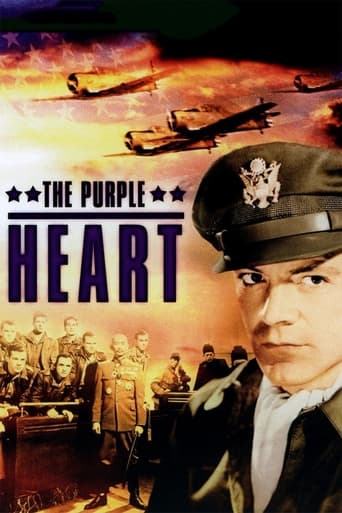ikanboy
Filmed in 1944 this movie has all the hallmarks of a jingoistic propaganda movie for the home front that was getting weary of the war. The racism and stereotyping is hardly subtle. A crew of a downed plane from the Doolitlle raid (the first attack on Japanese soil by the Yanks, all done to show the Japanese they were vulnerable) is put on trial for war crimes. They are tortured to reveal from where their raid originated. The Japanese Army wanted to humiliate the navy for allowing the raid (which came off American air craft carriers) and the men are pawns in the in fighting.The airmen are individually tortured off screen, and returned to their cells, all showing damage from the ordeal. Who will break? As this is a propaganda vehicle I'll leave you to guess if any of them do. In the end Dana Andrews gets to make a "we're coming to get you, you bastards" speech on the witness stand and the men are marched off to their doom.The acting is fine if overwrought. The script is clogged with "home sweet home" memories. Poems are recited, and battle hymns sung, and it's all too cloyingly ludicrous in 2007, or post 1970 for that matter. But I'm sure it left no dry eye in the audience, and it must have swelled the recruiting stations.Interesting is the fact that the crew is accused of bombing civilian targets. As if! No red blooded American would do that! Well we did. Not in this raid, but later in 1944-45. In addition to the 2 nukes we dropped we systematically, deliberately bombed major cities, causing fire storms and killing off 3/4 of a million Japanese civilians. As McNamara famously quotes General Le May, in "The fog of war": "if we lose we'll be tried as war criminals." We won, and the Americans marched on to the moral high ground!
Bill Smith
When "The Purple Heart" was shown in my hometown theater during the heat of World War II, it served as a reminder of what being a captive of the Japanese during this time frame was all about.Although some who were not around during this war may tag the picture as being "a little overdone", many who were placed in Japanese prisoner-of-war camps ... and lived to tell it ... will refer to this Twentieth-Century Fox release as "reels-of-authenticity; chilling realism."The decision to make the film in black-and-white, hinting at shadows of horror, adds to the impact of the terrible subject. Director Lewis Milestone was excellent, as always, and the acting by the cast, from Fox's stable of available war-time male stars, was exceptional.Incidentally, Don "Red" Barry was loaned to Fox by Republic Pictures for this movie. It was his dream that he would be contracted to the bigger, more important Twentieth-Century Fox after "The Purple Heart" was released. However, Republic's owner ... Herbert J. Yates ... considered the movie to be an important boost to Barry's marquee-value as a star from the studio's barn of "Saturday-Westerns". Don "Red" Barry would remain under contract to Republic ... making those good old "B" westerns ... for the rest of his professional career.
Richard Brandt
From the beginning I was impressed with Lewis Milestone's direction. The film opens in a darkened courtroom (although the emblem of the rising sun can be discerned on the far wall). A man in uniform enters and switches on the lights. Another man enters with a pitcher of water and begins preparing for the ritual of the judges' entrance. The first man begins opening the window blinds. This leisurely accumulation of detail gives these moments a documentary feel that lends verisimilitude to the events that follow. Even when the American heroes respond to their captors with caustic patriotic speeches, there's still an aura of realism that makes it hard to classify this movie along with the cruder propaganda efforts of the times.
rss2
Worth seeing for WWII and film history fans, this occasionally sappy film buys into the Hollywood anti-Japanese jingo-ism of the war while throwing in a few interesting curve balls.The story hangs on a show-trial of a captured American bomber crew for the charge of murder for killing civilians during the bombing of Tokyo in 1942. Anticipating the Nuremburg trials, the plot is a daring concept for a time (1943) when the U.S. still had no clear idea how the war would end!While the main characters adhere to the standard PR depiction of the Japanese as evil, cruel and hate-filled, there are interesting exceptions in the margins, particularly a kameo by Key Luke as a sailor who survives a shipwreck. He has to provide testimony that will either embarrass the army General prosecuting the case or his own Navy superiors. Tangential to be sure, but even this much sympathy for the Yellow Devil is almost unique for the period.It also goes to great pains to show that not all orientals are evil, with an extended subplot involving a Chinese soldier who dies a hero's death.Certainly, all the characters are highly emblematic - the Chinese soldier and his collaborationist father represent the divided China of the war, the foreign diplomats for whose benefit the show-trial is being conducted are all straight from central casting (note the conflicted Russian, not yet at war with Japan, who is driven finally to reject his own government!), and the crew are the typical rah-rah war movie accumulation of types and accents. But there are several extremely intelligent debates on war and responsibility to duty scattered through the film, along with a grudging admiration for the Japanese people as strong-willed and able to suffer deprivation for the sake of their ideals.Ultimately, the movie is carried mostly by the charm of the American crew, who manage to get through the most appallingly sentimental parts of the film with their dignity intact.




